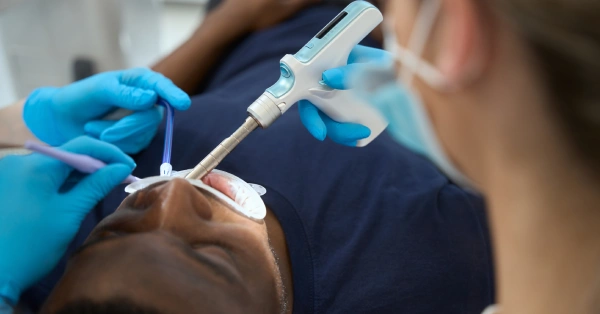How Sedation Dentistry in Washington Affects Healing
For many people, the thought of dental surgery can trigger anxiety and fear. Whether you’re preparing for a routine extraction or a complex oral procedure, staying calm is essential for both comfort and recovery. That’s where sedation dentistry comes in—it’s designed to make your dental experience more comfortable while also positively influencing your healing process. Sedation techniques are often used during advanced procedures where relaxation and pain control can make a significant difference in the outcome.
In our previous blog, we discussed the five-step recovery timeline following a sedation dentistry procedure. In this blog, we will go through the different types of sedation and their impacts so that patients can minimize stress, reduce inflammation, and recover more efficiently.
Types of Sedation and Their Impact on Healing
Below are the four primary types of sedation dentistry and how each can affect your recovery.
-
Nitrous Oxide Sedation (Laughing Gas)
Nitrous oxide is a mild and fast-acting sedative administered through a small mask placed over your nose. It helps patients stay relaxed and calm throughout the procedure without causing deep sleep.
How It Affects Healing:
- Quick Recovery Time: Nitrous oxide wears off almost immediately after the procedure, allowing you to return to daily activities sooner.
- Minimal Body Impact: Since it exits the system quickly, it doesn’t interfere with the body’s natural healing processes or immune function.
- Reduced Stress Response: Lower anxiety levels mean reduced cortisol production, supporting better blood flow and tissue repair.
- Less Post-Operative Fatigue: Most patients experience minimal grogginess, which helps them maintain normal activity and faster recovery.
Summary: This method of sedation dentistry in Washington is ideal for shorter or less invasive procedures, offering relaxation without lengthy downtime.
-
Oral Sedation (Pill Form)
Oral sedation involves taking prescribed medication before the procedure, helping to relieve anxiety while keeping you conscious. The effects range from mild to moderate, depending on dosage.
How It Affects Healing:
- Reduces Pre-Surgery Stress: By calming nerves before treatment, oral sedation helps your body prepare for smoother healing.
- Extended Relaxation Effect: The sedation may last several hours, which encourages rest and supports post-operative recovery.
- Decreased Inflammation: Relaxed muscles and reduced tension help minimize swelling at the treatment site.
- Temporary Delay in Eating or Drinking: Because of mild drowsiness, it’s best to wait until the sedation wears off before resuming a normal diet.
Summary: Oral sedation provides a deeper state of relaxation than nitrous oxide, making it suitable for moderate dental work or for patients with mild anxiety.
-
IV Sedation (Intravenous Sedation)
IV sedation delivers medication directly into the bloodstream for precise control over the depth of sedation. It’s frequently used during advanced surgical procedures, such as bone grafting in Washington or complex implant placements.
How It Affects Healing:
- Improved Procedure Efficiency: Deep relaxation allows the dentist to work more effectively, reducing tissue trauma and promoting faster recovery.
- Adjustable Sedation Level: Since it’s administered intravenously, the dose can be carefully managed to ensure safe, optimal results.
- Reduced Pain and Swelling: IV sedation minimizes the body’s pain response, resulting in less post-operative inflammation.
- Longer Rest Period Needed: Mild drowsiness may linger, so adequate rest and hydration afterward are essential for optimal healing.
Summary: IV sedation offers balanced control and comfort, making it a preferred choice for longer or more invasive dental treatments.
-
General Anesthesia
General anesthesia is the deepest form of sedation, where the patient is fully unconscious during the procedure. It’s typically reserved for extensive surgeries or patients with extreme anxiety or special medical needs.
How It Affects Healing:
- No Awareness During Procedure: Eliminates pain and stress, which can enhance overall recovery outcomes.
- Longer Recovery Time: Since the effects take time to wear off, patients may experience fatigue for up to 24–48 hours.
- Hydration Is Essential: Maintaining fluid intake helps the body eliminate waste more efficiently and aids in tissue healing.
- Requires Close Monitoring: Post-operative observation ensures safety and helps prevent complications during the recovery phase.
Summary: General anesthesia offers maximum comfort for major oral surgeries but requires a careful recovery plan and professional supervision.
Choosing the Right Sedation for Better Healing
The choice of sedation depends on the type of procedure, your health condition, and your level of anxiety. For instance, patients undergoing dental implants in Washington often benefit from IV or general sedation due to the complexity and duration of the procedure. Meanwhile, nitrous oxide or oral sedation may be sufficient for shorter treatments or patients with mild anxiety.
Conclusion:
Sedation dentistry not only helps patients remain calm during dental procedures but also plays a vital role in post-operative healing. By minimizing stress, controlling pain, and promoting better blood circulation, it enhances your overall recovery experience. Whether you are planning bone grafting, dental implant placement, or another form of oral surgery, understanding how different types of sedation impact your healing allows you to make confident, informed decisions for a healthier smile. Call now at (202) 610 0600!






4.9 Stars
based on 134 reviews
5 Stars
based on 11 reviews
5 Stars
based on 11 ratings